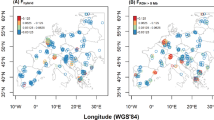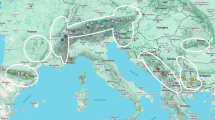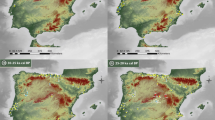Abstract
The dissection of S116 in more than 1500 individuals from Atlantic Europe and the Iberian Peninsula has provided important clues about the controversial evolutionary history of M269. First, the results do not point to an origin of M269 in the Franco–Cantabrian refuge, owing to the lack of sublineage diversity within M269, which supports the new theories proposing its origin in Eastern Europe. Second, S116 shows frequency peaks and spatial distribution that differ from those previously proposed, indicating an origin farther west, and it also shows a high frequency in the Atlantic coastline. Third, an outstanding frequency of the DF27 sublineage has been found in Iberia, with a restricted distribution pattern inside this peninsula and a frequency maximum in the area of the Franco–Cantabrian refuge. This entire panorama indicates an old arrival of M269 into Western Europe, because it has generated at least two episodes of expansion in the Franco–Cantabrian area. This study demonstrates the importance of continuing the dissection of the M269 lineage in different European populations because the discovery and study of new sublineages can adjust or even completely revise the theories about European peopling, as has been the case for the place of origin of M269.
Similar content being viewed by others
Log in or create a free account to read this content
Gain free access to this article, as well as selected content from this journal and more on nature.com
or
References
Pinhasi R, Thomas MG, Hofreiter M, Currat M, Burger J : The genetic history of Europeans. Trends Genet 2012; 28: 496–505.
Semino O, Passarino G, Oefner PJ et al: The genetic legacy of Paleolithic Homo sapiens sapiens in extant Europeans: a Y chromosome perspective. Science 2000; 290: 1155–1159.
Soares P, Achilli A, Semino O et al: The archaeogenetics of Europe. Curr Biol 2010; 4: R174–R183.
Cardoso S, Valverde L, Alfonso-Sánchez MA et al: The expanded mtDNA phylogeny of the Franco-Cantabrian region upholds the pre-neolithic genetic substrate of Basques. PLoS One 2013; 8: e67835.
Cinnioğlu C, King R, Kivisild T et al: Excavating Y chromosome haplotype strata in Anatolia. Hum Genet 2004; 114: 127–148.
Balaresque P, Bowden GR, Adams SM et al: A predominantly neolithic origin for European paternal lineages. PLoS Biol 2010; 8: e1000285.
Busby GB, Brisighelli F, Sánchez-Diz P et al: The peopling of Europe and the cautionary tale of Y chromosome lineage R-M269. Proc Biol Sci 2012; 279: 884–892.
Cruciani F, Trombetta B, Antonelli C et al: Strong intra- and inter-continental differentiation revealed by Y chromosome SNPs M269, U106 and U152. Forensic Sci Int Genet 2011; 5: e49–e52.
Myres NM, Rootsi S, Lin AA et al: A major Y-chromosome haplogroup R1b Holocene era founder effect in Central and Western Europe. Eur J Hum Genet 2011; 19: 95–101.
Klyosov A : Ancient history of the Arbins, bearers of haplogroup R1b, from central Asia to Europe, 16,000 to 1500 years before present. Advances in Anthropology 2012; 2: 87–105.
Goedbloed M, Vermeulen M, Fang RN et al: Comprehensive mutation analysis of 17 Y-chromosomal short tandem repeat polymorphisms included in the AmpFlSTR Yfiler PCR amplification kit. Int J Legal Med 2009; 123: 471–482.
Ballantyne KN, Goedbloed M, Fang O et al: Mutability of Y-chromosomal microsatellites: rates, characteristics, molecular bases, and forensic implications. Am J Hum Genet 2010; 87: 341–353.
Kayser M, Krawczak M, Excoffier L et al: An extensive analysis of Y-chromosomal microsatellite haplotypes in globally dispersed human populations. Am J Hum Genet 2001; 68: 990–1018.
Willuweit S, Roewer L : International Forensic Y Chromosome User Group: Y chromosome haplotype reference database (YHRD): update. Forensic Sci Int Genet 2007; 1: 83–87.
Zhivotovsky LA, Underhill PA, Cinnioğlu C et al: The effective mutation rate at Y chromosome short tandem repeats, with application to human population-divergence time. Am J Hum Genet 2004; 74: 50–61.
Shi W, Ayub Q, Vermeulen M et al: A worldwide survey of human male demographic history based on Y-SNP and Y-STR data from the HGDP-CEPH populations. Mol Biol Evol 2010; 27: 385–393.
Larmuseau MH, Vanderheyden N, Jacobs M, Coomans M, Larno L, Decorte R : Micro-geographic distribution of Y-chromosomal variation in the Central-Western European region Brabant. Forensic Sci Int Genet 2011; 5: 95–99.
Encarta Online Encyclopedia. Spain 2007, http://www.webcitation.org/5kwqnGivb.
Järve M, Zhivotovsky LA, Rootsi S et al: Decreased rate of evolution in Y chromosome STR loci of increased size of the repeat unit. PLoS One 2009; 4: e7276.
Mirabal S, Varljen T, Gayden T et al: Human Y-chromosome short tandem repeats: a tale of acculturation and migrations as mechanisms for the diffusion of agriculture in the Balkan Peninsula. Am J Phys Anthropol 2010; 142: 380–390.
Morelli L, Contu D, Santoni F, Whalen MB, Francalacci P, Cucca F : A comparison of Y-chromosome variation in Sardinia and Anatolia is more consistent with cultural rather than demic diffusion of agriculture. PLoS One 2010; 5: e10419.
Hervella M, Izagirre N, Alonso S et al: Ancient DNA from hunter-gatherer and farmer groups from northern Spain supports a random dispersion model for the Neolithic expansion into Europe. PLoS One 2012; 7: e34417.
Pala M, Olivieri A, Achilli A et al: Mitochondrial DNA signals of late glacial recolonization of Europe from near eastern refugia. Am J Hum Genet 2012; 90: 915–924.
Acknowledgements
Funds were provided by the Basque Government (IT-424-07). LV received a postdoctoral grant from the Basque Government (DKR-2012-439), applied through the Ikerbasque Foundation. The authors are deeply indebted to Emmanuelle Génin, Dan Bradley, Kevin Kenna, the Basque Foundation of Science (BIOEF), the Spanish National DNA Bank, SGIker (UPV/EHU, MICINN, GV/EJ, ERDF and ESF) and to all the people who voluntarily participated in this study.
Author contributions
LV and MMP conceived the study. JA, SC, KR, CF, OH, SJ, MFP, BMJ, JO, NM and MMP contributed samples/materials. LV, MJI, PV, AMG, AG and JO analysed the samples. LV analysed the data. LV and MMP wrote the manuscript. All co-authors reviewed the manuscript before submission.
Author information
Authors and Affiliations
Corresponding author
Ethics declarations
Competing interests
JA and SC are employed by the commercial company Progenika Biopharma SA (Grifols, Derio, Spain). This does not alter the authors’ adherence to all the policies on sharing data and materials. The remaining authors declare no conflict of interest.
Additional information
Supplementary Information accompanies this paper on European Journal of Human Genetics website
Rights and permissions
About this article
Cite this article
Valverde, L., Illescas, M., Villaescusa, P. et al. New clues to the evolutionary history of the main European paternal lineage M269: dissection of the Y-SNP S116 in Atlantic Europe and Iberia. Eur J Hum Genet 24, 437–441 (2016). https://doi.org/10.1038/ejhg.2015.114
Received:
Revised:
Accepted:
Published:
Issue date:
DOI: https://doi.org/10.1038/ejhg.2015.114
This article is cited by
-
Y-chromosome target enrichment reveals rapid expansion of haplogroup R1b-DF27 in Iberia during the Bronze Age transition
Scientific Reports (2022)
-
The Y chromosome of autochthonous Basque populations and the Bronze Age replacement
Scientific Reports (2021)
-
Phylogeographic review of Y chromosome haplogroups in Europe
International Journal of Legal Medicine (2021)
-
The Marquesans at the fringes of the Austronesian expansion
European Journal of Human Genetics (2019)
-
The Beaker phenomenon and the genomic transformation of northwest Europe
Nature (2018)



